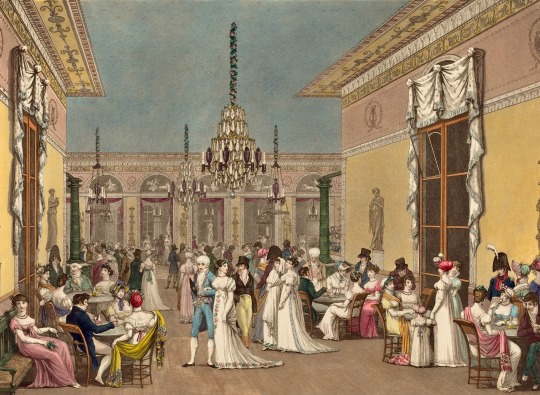#after François Flameng
Explore tagged Tumblr posts
Text

H. Lefort, after François Flameng - The child at the gallows. Illustration of Victor Hugo's novel 'The Man Who Laughs', 1869.
23 notes
·
View notes
Text


Top: Café Frascati in Paris, 1807, by Philibert-Louis Debucourt
Bottom: Café Frascati (A Scene From Napoleon's Time), 1893, by François Flameng
During the Premier Empire, the Frascati establishment, named after a famous Neapolitan ice-cream maker, was one of the most popular venues in Paris. First of all, it had a delightful garden, decorated with the busts of the greatest French and English poets, and lit up at night. A tunnel of wisteria and maiden vine, known as “l’ermitage” (the retreat), lent a charming atmosphere to the scene. The house was used as a café and salon de pâtisserie. On the ground floor it offered refreshments and some of the best ice-cream in Paris, with ballrooms. On the first floor were gaming rooms. Paris’s smartest set flocked here to spend the pleasant summer evenings.
The Maison Frascati closed at the Restoration, following the law closing down gaming rooms. (Source)
#Café Frascati#Philibert-Louis Debucourt#Debucourt#François Flameng#Flameng#napoleon#napoleonic era#napoleonic#first french empire#napoleon bonaparte#French empire#19th century#1800s#france#history#art#belle époque#French art#19th century art#empire style#empire#prints#paintings#painting
83 notes
·
View notes
Photo


“At Auxonne, his second garrison, the young Bonaparte escaped death three times. The first, during a drowning, in 1789, at the age of twenty. (He was swimming in the Saone.) Seized by a cramp, he lost consciousness, felt life escaping from him, heard his comrades fidgeting, running on the bank, shouting that he was lost, asking for boats to fish him out. Finally, he sank to the bottom of the river. But his chest struck against a sandbank, his head emerged, he regained consciousness and, thanks to the current, he regained consciousness, got out of the water, not without vomiting a lot, he got dressed and returned to his lodgings.
The following year, he was involved in two duel cases. For the beautiful eyes of a pretty girl, Manesca Pillet, he fights with a sword with a rival, Denis Grosey, who slightly wounds him. Then he quarrels with a comrade, Lieutenant Belly de Bussy, who annoys him by playing the horn, very badly moreover, in the room above his and prevents him from working. Passing him on the stairs, Bonaparte calls out to him:
"My dear, you must get tired with your accursed instrument." "But no not at all." "Well, you are tiring the others." "I'm sorry about that." “But you better go give your horn away.” "I am the master in my room." "You could be given some doubt on that." "I don't think anyone was bold enough."
An appointment is made to fight. But the previous year, Napoleon himself drawn up the rules which obliged them to submit their disputes or differences. It was decided by the jury that in the future Bussy would be allowed to continue playing the horn and that Bonaparte would have to show himself more enduring.
Chance would have it that Napoleon met Bussy much later, on March 6, 1814, during the Battle of Craonne, in the Aisne. On that day, to find out about the enemy's positions and the topography of the surroundings, the emperor sent two aides-de-camp to seek out the mayor of Beaurieux, a neighboring village. Napoleon recognizes him: It's Bussy.
After emigrating during the Revolution, he returned to take care of his land, where he lived alone. "Well! Bussy, Napoleon says, do you still play the horn?" "Yes sire, and still so false." Bussy will guide him and follow him throughout the rest of the French countryside, still in hunting costume, for lack of being able to obtain a uniform. The soldiers call it " the emperor's pekin.”
- From the book: Napoléon face à la mort by Alain Frèrejean.
The first image shows Napoleon studying at Auxonne by François Flameng and the second is a meme I quickly made that fits the second story perfectly.
101 notes
·
View notes
Photo

738 notes
·
View notes
Text

Ricardo de Los-Rios, after François Flameng - The Grim Reaper. From 'Les Misérables' by Victor Hugo (“Javert derailed”, volume V, book four), circa 1885.
9 notes
·
View notes